White-Rot Fungal Pretreatment for High-Performance Bamboo-Derived Carbon-Based Supercapacitor Electrodes
Abstract
1. Introduction
2. Results and Discussion
2.1. SEM of Original Bamboo and Bamboo Pretreated with White-Rot Fungi
2.2. FTIR
2.3. SEM of MnO2-, Hyphae-, and Bamboo-Derived Carbon
2.4. Pore Structure
2.5. XRD and Raman
2.6. Electrochemical Performance
3. Materials and Methods
3.1. Materials
3.2. Methods
3.2.1. Preparation of River Sand Sawdust Media
3.2.2. Test Bacteria Inoculation and Cultivation
3.2.3. Inoculation of Samples
3.2.4. Preparation of Hypha/Bamboo-Based Carbon Material
3.2.5. Preparation of MnO2/Hypha/Bamboo-Based Carbon Material
3.2.6. Preparation of Comparative Samples
3.2.7. Characterization
3.2.8. Electrochemical Testing
4. Conclusions
Author Contributions
Funding
Institutional Review Board Statement
Informed Consent Statement
Data Availability Statement
Conflicts of Interest
References
- Plavniece, A.; Volperts, A.; Dobele, G.; Zhurinsh, A.; Kaare, K.; Kruusenberg, I.; Kaprans, K.; Knoks, A.; Kleperis, J. Wood and black liquor-based N-doped activated carbon for energy application. Sustainability 2021, 13, 9237. [Google Scholar] [CrossRef]
- Chen, L.; Wang, F.; Tian, Z.; Guo, H.; Cai, C.; Wu, Q.; Du, H.; Liu, K.; Hao, Z.; He, S. Wood-Derived High-Mass-Loading MnO2 Composite Carbon Electrode Enabling High Energy Density and High-Rate Supercapacitor. Small 2022, 18, 2201307. [Google Scholar] [CrossRef]
- Kim, J.H.; Lee, H.M.; Jung, S.C.; Chung, D.C.; Kim, B.J. Bamboo-based mesoporous activated carbon for high-power-density electric double-layer capacitors. Nanomaterials 2021, 11, 2750. [Google Scholar] [CrossRef]
- Chen, G.; Li, Y.; Han, E.; Zhang, Z.; Yang, X.; Zhou, D.; He, Y. B and N Co-Doped Wood Scrap Charcoal for Decorated Supercapacitor with High Conductivity. Forests 2023, 14, 965. [Google Scholar] [CrossRef]
- Balducci, A.; Belanger, D.; Brousse, T.; Long, J.W.; Sugimoto, W. Perspective-A guideline for reporting performance metrics with electrochemical capacitors: From electrode materials to full devices. J. Electrochem. Soc. 2017, 164, 1487–1488. [Google Scholar] [CrossRef]
- Su, H.; Lan, C.; Wang, Z.; Zhu, L.; Zhu, M. Controllable Preparation of Eucommia Wood-Derived Mesoporous Activated Carbon as Electrode Materials for Supercapacitors. Polymers 2023, 15, 663. [Google Scholar] [CrossRef]
- Jayachandran, M.; Babu, S.K.; Maiyalagan, T.; Rajadurai, N.; Vijayakumar, T. Activated carbon derived from bamboo-leaf with effect of various aqueous electrolytes as electrode material for supercapacitor applications. Mater. Lett. 2021, 301, 130335. [Google Scholar] [CrossRef]
- Long, J.W.; Brousse, T.; Belanger, D. Electrochemical capacitors: Fundamentals to applications. J. Electrochem. Soc. 2015, 162, Y3. [Google Scholar] [CrossRef]
- Gogotsi, Y.; Penner, R.M. Energy storage in nanomaterials-capacitive, pseudocapacitive, or battery-like? ACS Nano 2018, 12, 2081–2083. [Google Scholar] [CrossRef]
- Chen, F.; Zhang, Y.; Zheng, M.; Xiao, Y.; Hu, H.; Liang, Y.; Liu, Y.; Dong, H. Preparation of high-performance porous carbon materials by citric acid-assisted hydrothermal carbonization of bamboo and their application in electrode materials. Energy Fuels 2022, 36, 9303–9312. [Google Scholar] [CrossRef]
- Yalovega, G.E.; Brzhezinskaya, M.; Dmitriev, V.O.; Shmatko, V.A.; Ershov, I.V.; Ulyankina, A.A.; Chernysheva, D.V.; Smirnova, N.V. Interfacial interaction in MeOx/MWNTs and CuOx/MWNTs nanostructures as efficient electrode materials for high-performance supercapacitors. Nanomaterials 2024, 14, 947. [Google Scholar] [CrossRef]
- Ke, Z.; Lin, L.; Jian, Z.; Jing, L.; Bo, X. Research progress on pore structure and regulation methods of biomass carbon materials. New Chem. Mater. 2023, 51, 48–54. [Google Scholar]
- Liu, J.; Zhang, K.; Wang, H.; Lin, L.; Zhang, J.; Li, P.; Zhang, Q.; Shi, J.; Cui, H. Advances in Micro-/Mesopore Regulation Methods for Plant-Derived Carbon Materials. Polymers 2022, 14, 4261. [Google Scholar] [CrossRef] [PubMed]
- Kong, W.; Zhang, X.; Fu, X.; Zhou, C.; Fan, L.; Zhang, W. Biological pretreatment with white rot fungi for preparing hierarchical porous carbon from Banlangen residues with high performance for supercapacitors and dye adsorption. Front. Microbiol. 2024, 15, 1374974. [Google Scholar] [CrossRef] [PubMed]
- Zhang, H.; Jiang, Y.; Liu, Y.; Li, Q. Chromatic aberration and decay resistance performance of bamboo and bamboo scrimber decayed by white-rot and brown-rot fungi. Wood. Mater. Sci. Eng. 2023, 18, 1841–1847. [Google Scholar] [CrossRef]
- Xia, Y.; Zuo, H.; Lv, J.; Wei, S.; Yao, Y.; Liu, Z.; Lin, Q.; Yu, Y.; Yu, W.; Huang, Y. Preparation of multi-layered microcapsule-shaped activated biomass carbon with ultrahigh surface area from bamboo parenchyma cells for energy storage and cationic dyes removal. J. Clean. Prod. 2023, 396, 136517. [Google Scholar] [CrossRef]
- Cao, J.; Lin, L.; Zhang, J.; Zhao, F.; Shi, J.; Guan, F.; Wang, D. Biological treatment as a green approach for enhancing electrochemical performance of wood derived carbon based supercapacitor electrodes. J. Clean. Prod. 2023, 422, 138659. [Google Scholar] [CrossRef]
- Rabchinskii, M.K.; Besedina, N.A.; Brzhezinskaya, M.; Stolyarova, D.Y.; Ryzhkov, S.A.; Saveliev, S.D.; Antonov, G.A.; Baidakova, M.V.; Pavlov, S.I.; Kirilenko, D.A. Graphene amination towards its grafting by antibodies for biosensing applications. Nanomaterials 2023, 13, 1730. [Google Scholar] [CrossRef] [PubMed]
- Rabchinskii, M.K.; Shnitov, V.V.; Brzhezinskaya, M.; Baidakova, M.V.; Stolyarova, D.Y.; Ryzhkov, S.A.; Saveliev, S.D.; Shvidchenko, A.V.; Nefedov, D.Y.; Antonenko, A.O.; et al. Manifesting epoxide and hydroxyl groups in XPS spectra and valence Band of graphene derivatives. Nanomaterials 2023, 13, 23. [Google Scholar] [CrossRef]
- Qi, J.; Jia, L.; Liang, Y.; Luo, B.; Zhao, R.; Zhang, C.; Wen, J.; Zhou, Y.; Fan, M.; Xia, Y. Fungi’s selectivity in the biodegradation of Dendrocalamus sinicus decayed by white and brown rot fungi. Ind. Crop. Prod. 2022, 188, 115726. [Google Scholar] [CrossRef]
- Zhang, W.; Yang, Y.; Xia, R.; Li, Y.; Zhao, J.; Lin, L.; Cao, J.; Wang, Q.; Liu, Y.; Guo, H. Graphene-quantum-dots-induced MnO2 with needle-like nanostructure grown on carbonized wood as advanced electrode for supercapacitors. Carbon 2020, 162, 114–123. [Google Scholar] [CrossRef]
- Yu, J.; Li, M.; Wang, X.; Yang, Z. Promising high-performance supercapacitor electrode materials from MnO2 nanosheets@ bamboo leaf carbon. ACS Omega 2020, 5, 16299–16306. [Google Scholar] [CrossRef] [PubMed]
- Zhang, Z.; Lu, S.; Li, Y.; Song, J.; Han, E.; Wang, H.; He, Y. Promoting hierarchical porous carbon derived from Bamboo via copper doping for high-performance supercapacitors. Ind. Crop. Prod. 2023, 203, 117155. [Google Scholar] [CrossRef]
- Zhao, F.; Lin, L.; Zhang, J.; Liu, J.; Shi, J.; LeGodec, Y.; Courac, A. Ice-Templating: Integrative Ice Frozen Assembly to Tailor Pore Morphology of Energy Storage and Conversion Devices. Adv. Mater. Technol. 2023, 8, 2201968. [Google Scholar] [CrossRef]
- Wang, Z.; Wen, S.; Ma, J.; Li, Z.; Wang, J.; Liu, X. Bamboo fiber-derived porous carbon microspheres decorated with MnO2 for enhanced supercapacitor performance. Diam. Relat. Mater. 2023, 140, 110451. [Google Scholar] [CrossRef]
- Hu, W.; Wang, B.; Yu, Y.; Wang, N.; Wu, X. Biomass derived carbon containing in-situ constructed nickel-based hydroxide nanostructures based on MnO2 template for high performance asymmetric supercapacitors. J. Alloys Compd. 2021, 884, 161149. [Google Scholar] [CrossRef]
- Han, J.; Ping, Y.; Yang, S.; Zhang, Y.; Qian, L.; Li, J.; Liu, L.; Xiong, B.; Fang, P.; He, C. High specific power/energy, ultralong life supercapacitors enabled by cross-cutting bamboo-derived porous carbons. Diam. Relat. Mater. 2020, 109, 108044. [Google Scholar] [CrossRef]
- Zeng, H.; Xing, B.; Zhang, C.; Chen, L.; Zhao, H.; Han, X.; Yi, G.; Huang, G.; Zhang, C.; Cao, Y. In situ synthesis of MnO2/porous graphitic carbon composites as high-capacity anode materials for lithium-ion batteries. Energy Fuels 2020, 34, 2480–2491. [Google Scholar] [CrossRef]
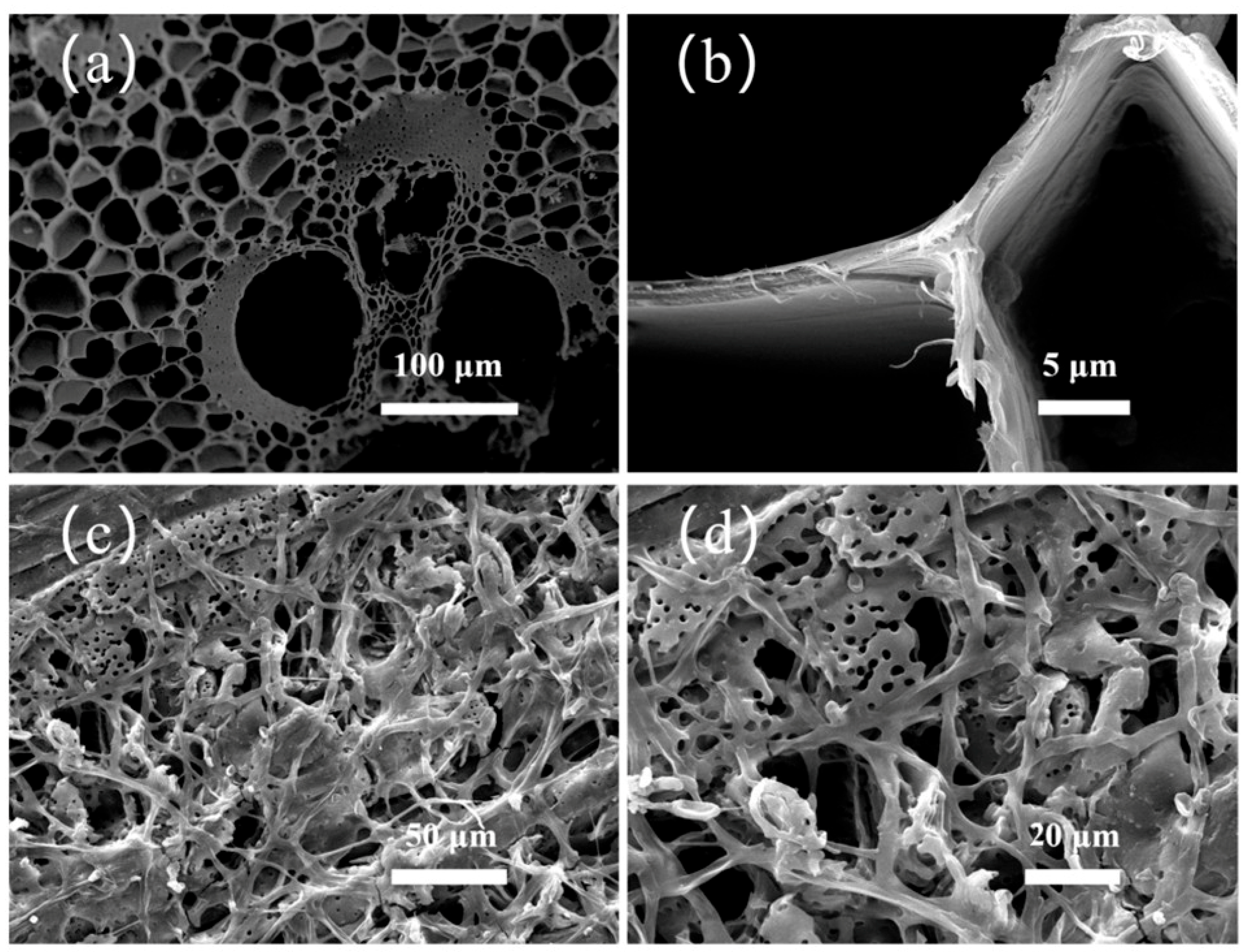
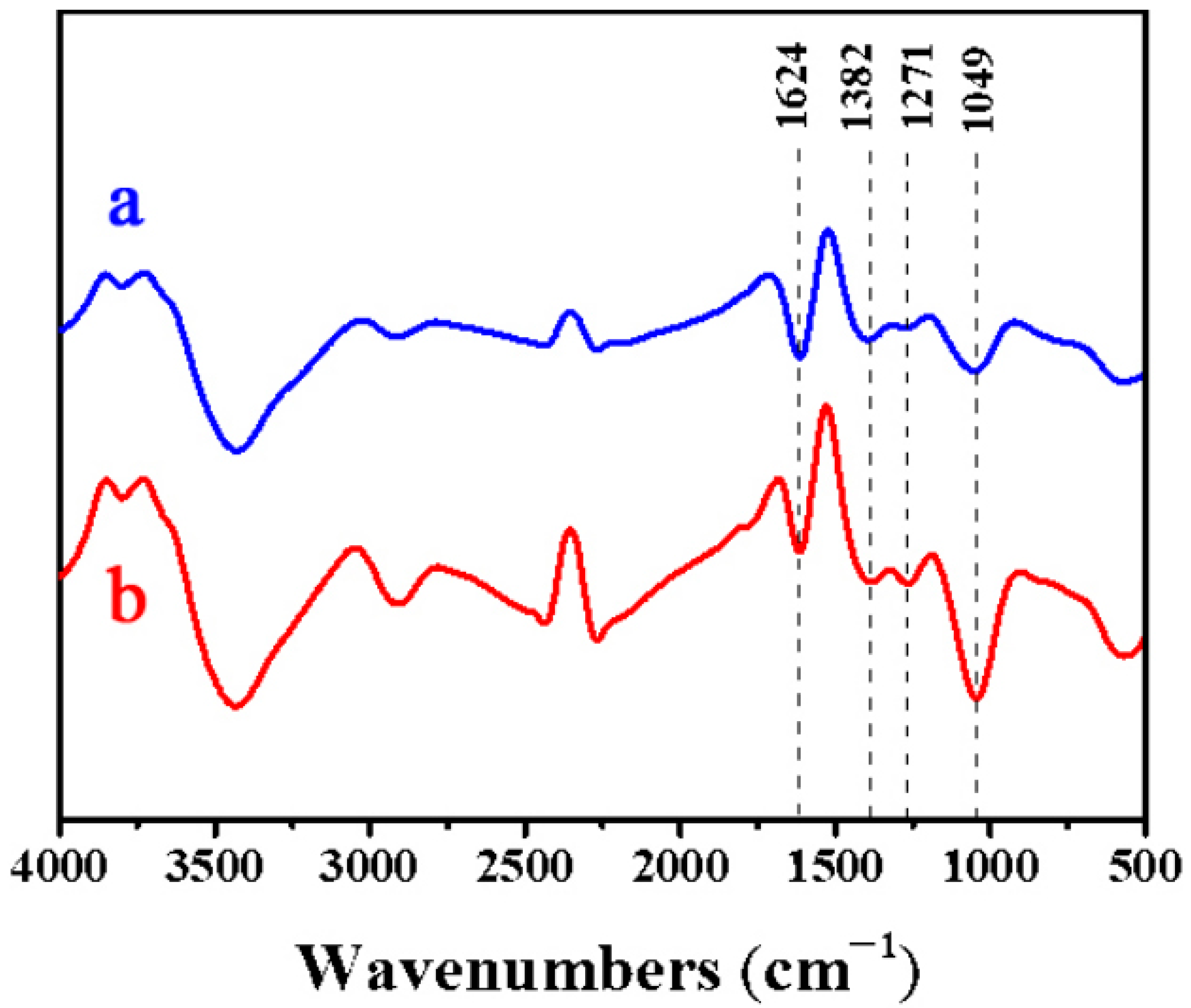

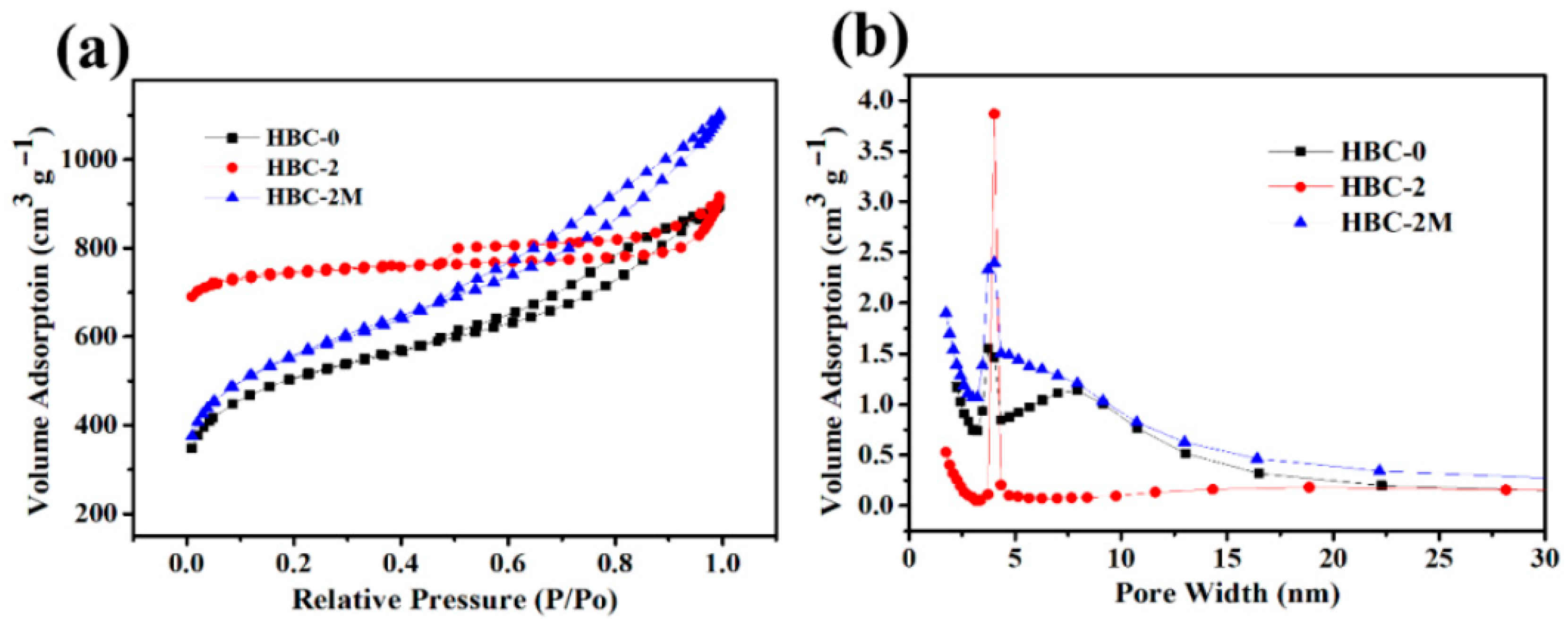
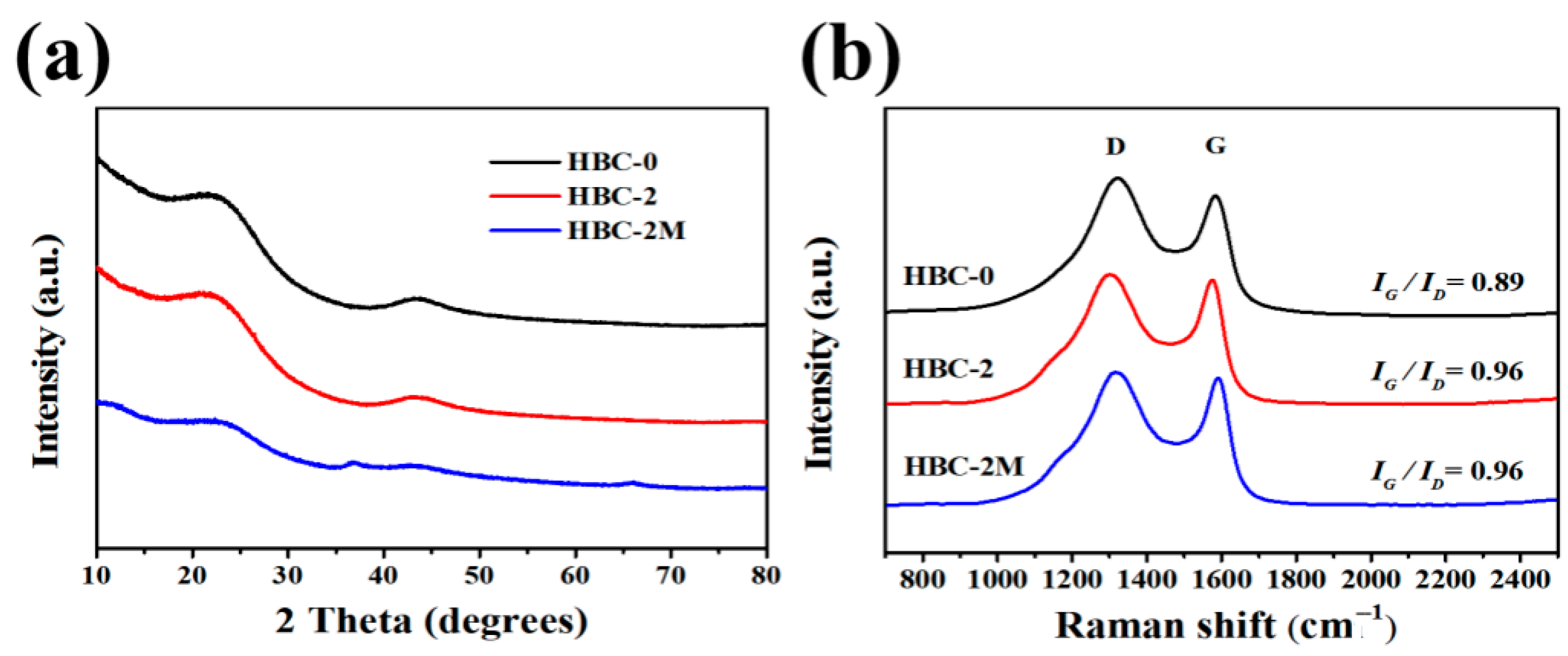
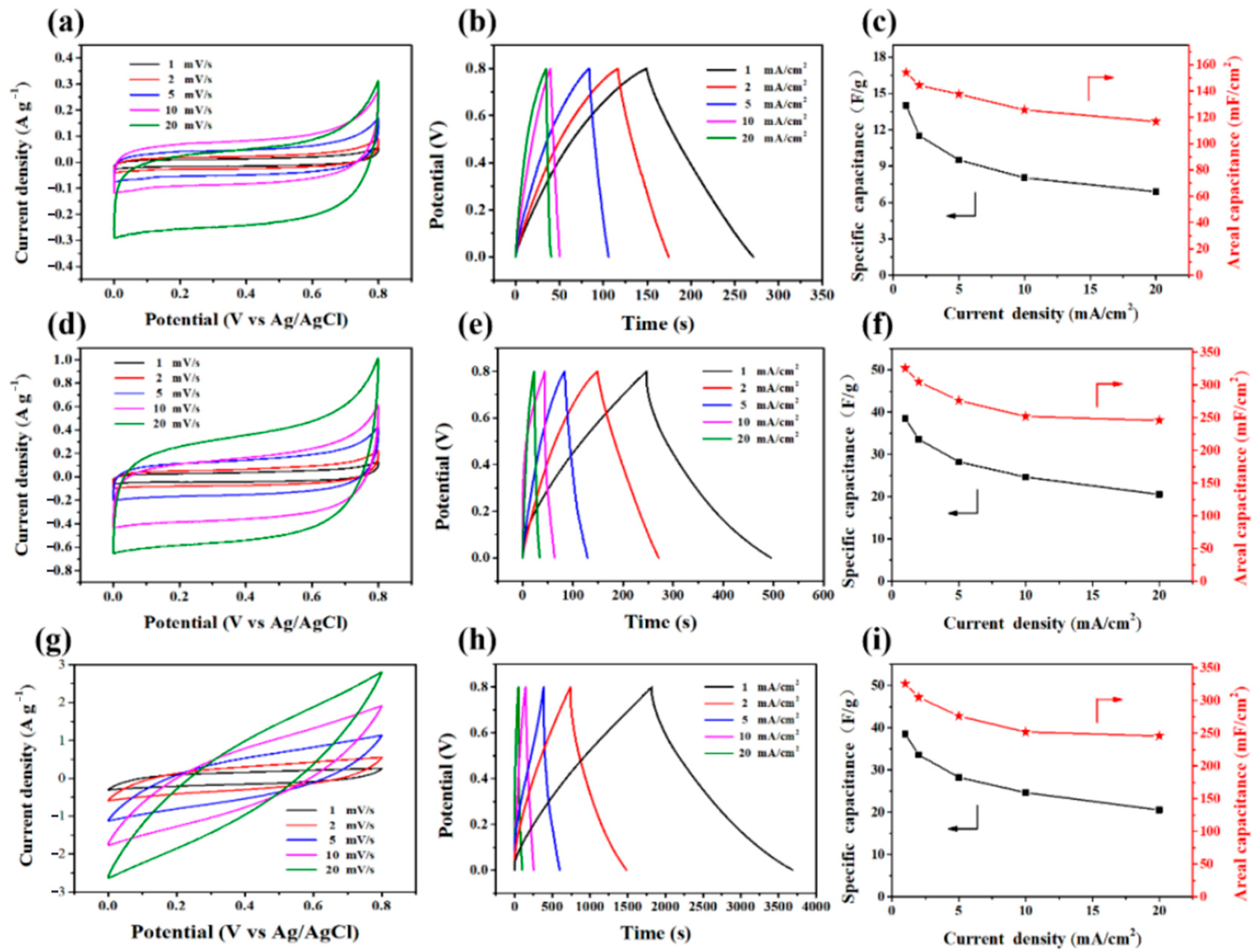
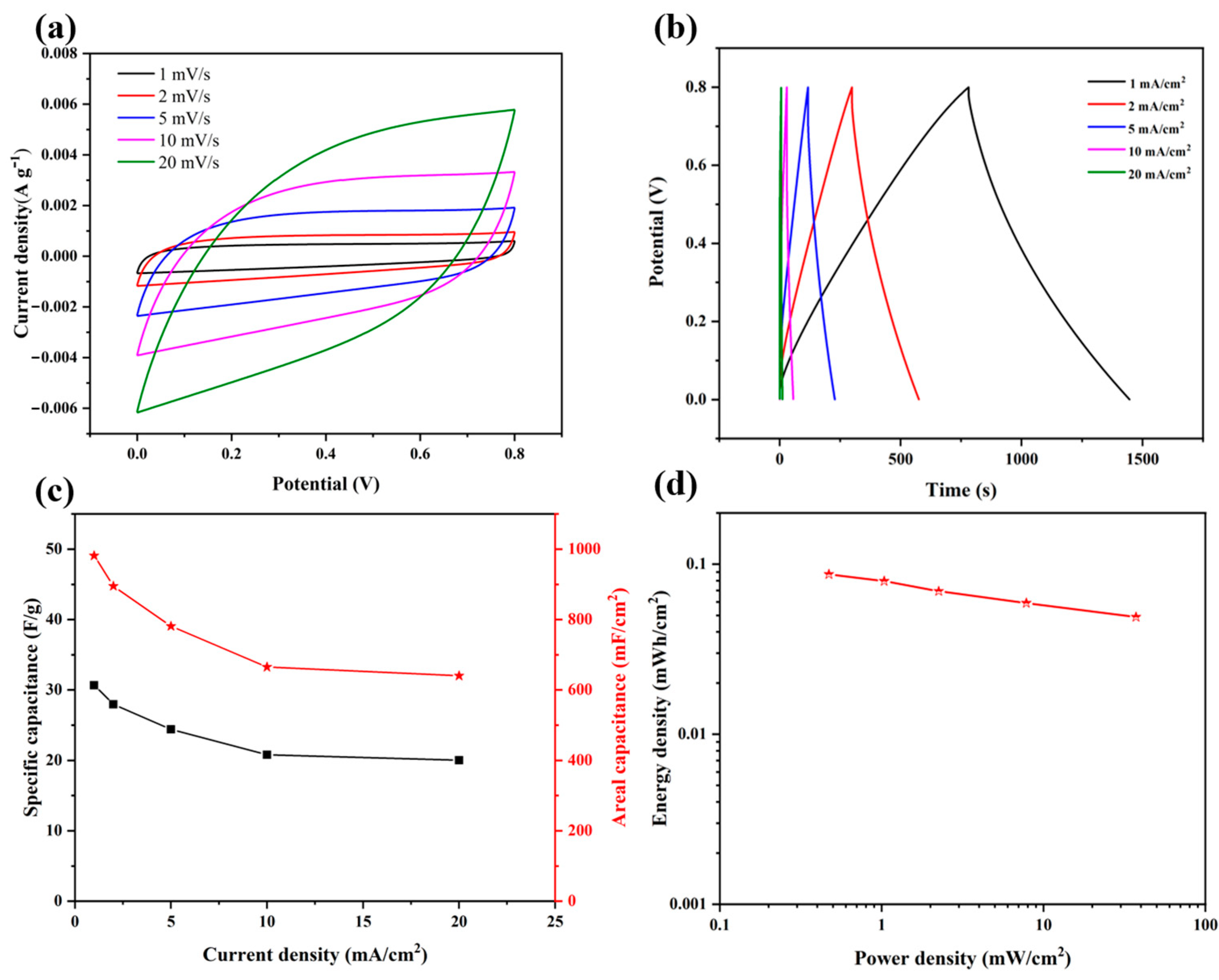
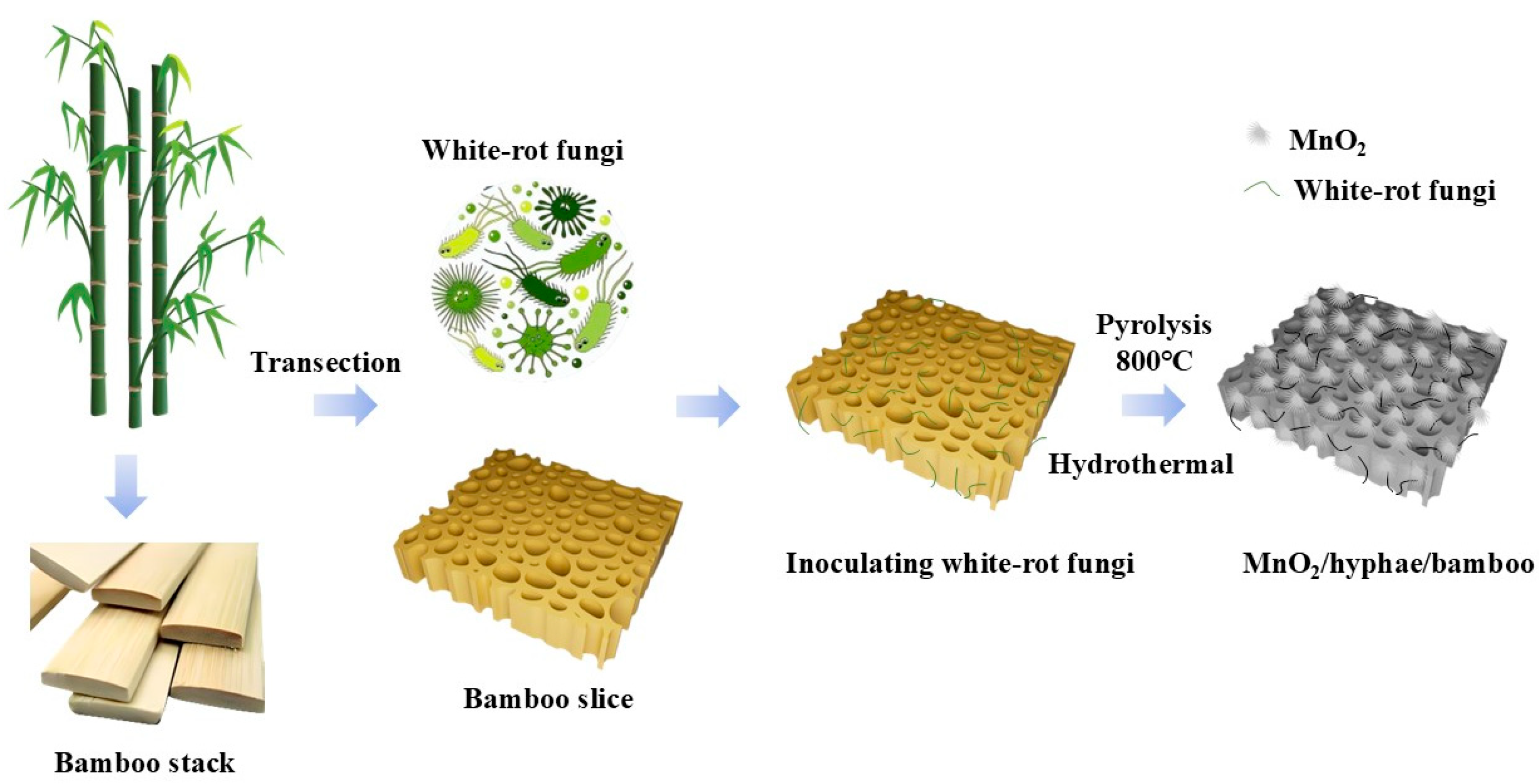
| Wavenumber (cm−1) | Primary Assignment | Bond/Functional Group Vibration Type |
|---|---|---|
| 1049 | Cellulose /hemicellulose | C–O–C ether bond stretching vibration C–O stretching vibration (primary/secondary alcohols) [18] |
| 1624 | Lignin | Aromatic ring C=C stretching vibration (benzene ring skeleton) Conjugated carbonyl C=O stretching vibration |
| 1382 | Lignin | Phenolic O–H in-plane bending vibration [19] Aliphatic C–H bending vibration (–CH3, –CH2–) |
| 1271 | Lignin (Guaiacyl unit) | Guaiacyl ring C–O stretching vibration (aromatic ether Ar–O–CH3) |
Disclaimer/Publisher’s Note: The statements, opinions and data contained in all publications are solely those of the individual author(s) and contributor(s) and not of MDPI and/or the editor(s). MDPI and/or the editor(s) disclaim responsibility for any injury to people or property resulting from any ideas, methods, instructions or products referred to in the content. |
© 2025 by the authors. Licensee MDPI, Basel, Switzerland. This article is an open access article distributed under the terms and conditions of the Creative Commons Attribution (CC BY) license (https://creativecommons.org/licenses/by/4.0/).
Share and Cite
Zhang, J.; Lin, L.; Jiang, T.; Cao, J.; Zhang, J.; Qin, J.; Liang, H. White-Rot Fungal Pretreatment for High-Performance Bamboo-Derived Carbon-Based Supercapacitor Electrodes. Molecules 2025, 30, 3430. https://doi.org/10.3390/molecules30163430
Zhang J, Lin L, Jiang T, Cao J, Zhang J, Qin J, Liang H. White-Rot Fungal Pretreatment for High-Performance Bamboo-Derived Carbon-Based Supercapacitor Electrodes. Molecules. 2025; 30(16):3430. https://doi.org/10.3390/molecules30163430
Chicago/Turabian StyleZhang, Jian, Lin Lin, Tianyao Jiang, Jiaming Cao, Jun Zhang, Jing Qin, and Hengnan Liang. 2025. "White-Rot Fungal Pretreatment for High-Performance Bamboo-Derived Carbon-Based Supercapacitor Electrodes" Molecules 30, no. 16: 3430. https://doi.org/10.3390/molecules30163430
APA StyleZhang, J., Lin, L., Jiang, T., Cao, J., Zhang, J., Qin, J., & Liang, H. (2025). White-Rot Fungal Pretreatment for High-Performance Bamboo-Derived Carbon-Based Supercapacitor Electrodes. Molecules, 30(16), 3430. https://doi.org/10.3390/molecules30163430






